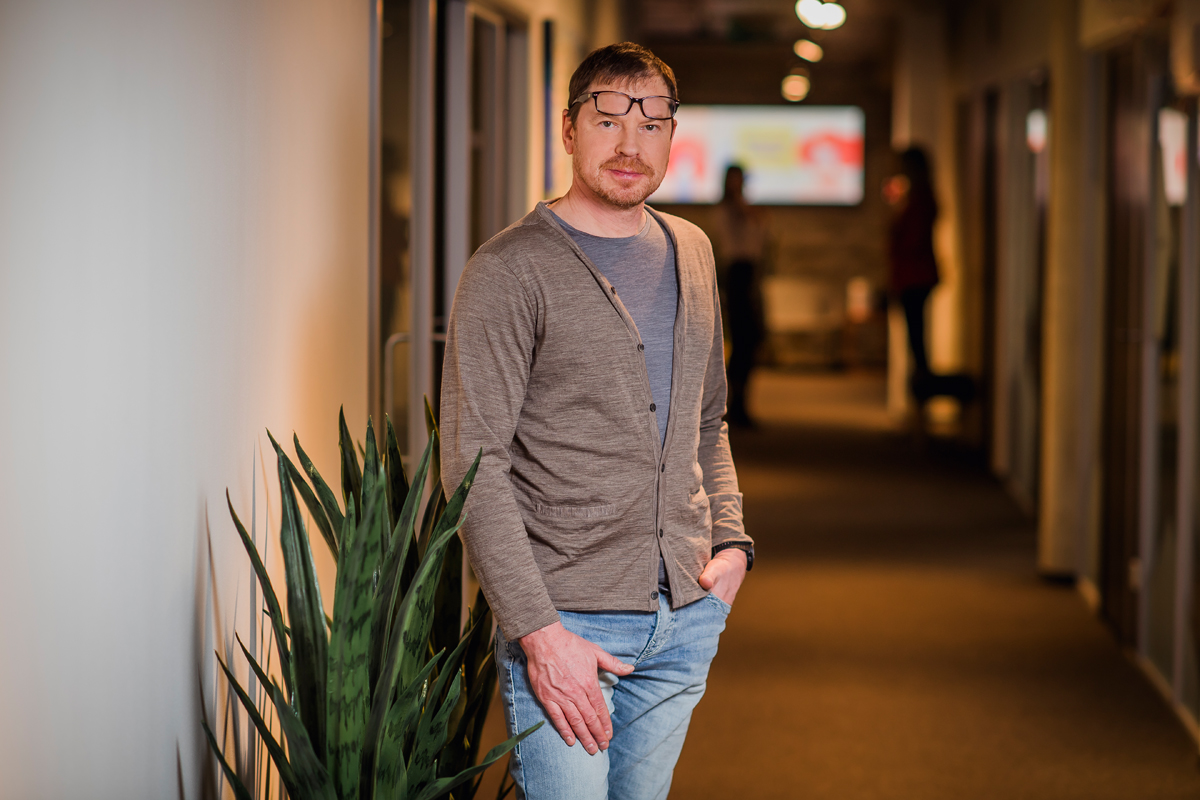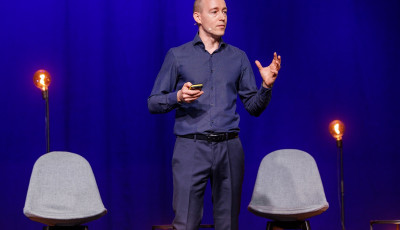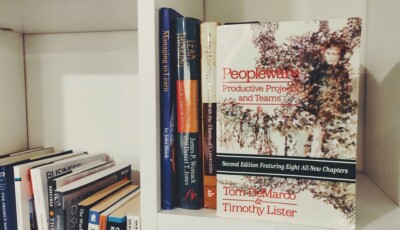Jaan Pillesaar, CEO and founder of Helmes sits down with us to talk about comprehensive and thoughtful approaches to well-being within the workplace and its ripple effects on professional environments. Pillesaar shares how prioritizing his own well-being has had on his leadership style and the overall culture and management approach at Helmes, and how the company has integrated well-being into its business strategy, resulting in improved company performance and a thriving organizational culture.
Learn how Helmes is the best place to work and grow
How do you define well-being for yourself, and what do you do to maintain it?
For me, well-being is when you wake up in the morning, feel good about the day ahead, and want to make the world a better place. It also means relationships full of warmth and understanding.
I make it a point not to criticize or blame anyone when something goes awry. Mistakes are a normal part of life. Sometimes, however, we have to make difficult decisions. I try to make these decisions in a way that causes as little harm as possible to the people involved. By being as good as possible to people, you also protect yourself from negative feelings.
I try to work a reasonable amount and take enough time off. I do some form of exercise almost every day, and I recommend others do the same. I have forced people to go on vacation when it’s evident they are close to burnout. Health comes before money.
Could you share an experience when focusing on your well-being significantly impacted your professional life?
For the longest time, I focused mainly on the well-being of my clients and employees and overlooked my own needs. This is not a sustainable long-term approach. If you end up breaking yourself, you can no longer help others.
Lately, I’ve been thinking a lot more about myself. Last year, I took a month and a half off for therapy leave. It made me feel calmer, more understanding, and more creative in all aspects of my work. I have successfully mentally distanced myself from problems. By stepping off the wheel for a change, you learn to view problems from the outside without letting them get you down.
How does your perception of well-being influence your management style and company culture?
I want Helmes to be the kind of company that every employee will think of as the best job they ever had once they grow old. I guess everyone has a different idea of what makes a workplace “the best”. At Helmes, we have defined it as a workplace that helps talented people realize their full professional potential while maintaining their mental and physical well-being.
We want to be the best partner for the self-development of our employees. Our mission, “Best partner for growth,” is all about holistic human development. Our ideal is long-term employment where employees do not fall into unhealthy patterns and instead feel mentally and physically healthy, live balanced lives, and enjoy professional development. Holistic employee development feeds into business development.
As a manager, I have always tried to give people a lot of freedom. I’ve never dished out orders, and I try to avoid imposing restrictions wherever possible. I let everyone make their own plans and come up with their own solutions while allowing for reasonable mistakes to be made along the way. If something needs to change, we share feedback in a friendly way and encourage learning. We only intervene in people’s work if there is a clear misalignment with our values or a significant problem with any of our three benchmarks.
The same principles are shared by other managers, mentors and leaders at Helmes – it is impossible to create an organizational culture alone. A manager’s main task is to bring together caring, independent, and talented people and give them the opportunity and confidence to shape a shared vision and contribute their best to make it a reality.
How has prioritizing employee well-being affected your company’s performance and productivity?
Helmes offers services. We create strategic digital solutions for different organizations. The well-being, motivation, and professional competence of our employees are crucial to the quality and value of our work. Studies show that satisfied and happy employees are up to 40% more productive.
To ensure managers focus on employee well-being daily, we measure teams against three progress indicators – employee well-being, customer satisfaction, and financial efficiency. A team is successful if all these indicators are good or very good. Experience shows that all these measures are interlinked. The better the employee rating, the more satisfied customers are with the service. Both these, in turn, lead to financial performance.
We measure performance on a team-by-team basis, but there is a lot to be proud of when you take stock of Helmes’ overall results. We measure employee satisfaction with the CultureAmp survey, which ranks us in the top 25% of New Tech Europe Companies.
Our net promoter score of 66 is more than double the score generally considered excellent in the tech industry (NPS 30). Most of our customers consider us to be the best external software development partner to have.
The cost-effectiveness of software solutions is harder to measure because they are incredibly diverse. Overall, we can say that our customers consider the time-to-value of our solutions to be very competitive in the international market. Our long-standing strong customer relationships are proof of this. We rarely lose customers.
We have invested heavily in employee well-being and development, and we can see that this has significantly impacted the quality of service. This is also backed up by Helmes’ financial results: as a service company, we have grown faster than most successful start-ups in the global market in recent years.
How do you integrate the concept of well-being into your business strategies and decisions?
The well-being and development of our employees is a key premise of our value proposition, which is why it is at the heart of our strategy. We invest heavily in employee well-being and development initiatives.
Caring for employees starts with careful recruitment. We try to find people attracted to our company culture, where people take priority and self-development is valued. Their line manager mainly influences the well-being of an employee. That is why we also approach manager recruitment with great care and attention. We also invest heavily in development training for managers.
I do believe that the well-being of our people drives every decision we make. All teams at Helmes measure their success against the well-being of their team members and customers, and we recruit leadership who genuinely cares about people.
What initiatives has your organization introduced to promote employee well-being, and what have been the results?
The employee well-being and development strategy contains so many different initiatives that listing them all would simply take too long. I can give you some examples, though.
We recently launched a comprehensive mentoring program. It builds on the belief that individual growth is the most important aspect of unpacking personal experience and using it to support others, for example, through mentoring. We plan to make the mentoring program available to everyone at Helmes.
We have created detailed competency models for our so-called “T-shaped” employees – those with a lot of specialist knowledge in a specific area who also make connections across disciplines – to support their professional development. This allows us to provide employees with a thorough and objective understanding of the skills expected at different levels of their roles. This allows everyone to assess their professional skills accurately and plan their professional development up to 10 years in advance.
Our well-being surveys show that:
- 97% of employees at Helmes say their manager genuinely cares about their well-being and values their work.
- 96% of employees feel valued and cared for by other employees.
- 94% of employees perceive well-being as a strategic priority for Helmes that the organization works towards every day.
The numbers speak for themselves. We have also received both local and international recognition as an employer. For example, we recently celebrated winning the Best HR Team award in the EMEA region. And in 2022, Helmes was selected as one of 10 prime examples in the European Parliament’s annual survey on inclusive governance.
From your perspective, what are some emerging organizational well-being trends, and how might they shape work in the future?
I believe we have reached an era where responsible organizations consider it only natural to set up an environment supporting the employee’s comprehensive or holistic development. Businesses have a shared responsibility to ensure that people remain in the labor market for as long as possible and in a sustainable way – happy, healthy, and in good professional shape. By publicly sharing our practices at Helmes, we have contributed to this change.
What is your prediction for the role of technology in improving workplace well-being?
Technology is important in understanding people’s emotions, conducting surveys, and analyzing the results. The more data we have on people’s behavior, attitudes, and experiences, the better we can analyze them to make it easier to design better job roles and maintain health.
AI, for example, is a rapidly evolving tool that will hopefully further improve our understanding of what exactly impacts our mental and physical well-being. How can we feel motivated, supported, and involved? What should the physical workplace be like? What should the work culture be like so that people can perform at their best?
What challenges have you encountered in implementing well-being initiatives, and how have you overcome them?
One of the challenges is to make sure the initiatives are personalized enough to more accurately meet the needs of different people. At Helmes, we see that it is important to build towards the kind of learning and teaching environment where people can choose the methods that suit them and take control of their own well-being.
Such an environment requires a high level of self-awareness and self-management, which is often the first thing to learn. We see that many employees struggle to establish a foundation – healthy well-being patterns as well as new learning habits. We are working on clever ways to integrate well-being as a skill into all work activities to support the formation of healthy mindsets and practices.
What opportunities do you see for other top managers seeking to improve well-being in their organizations?
I believe that we would now consider it a basic management fact that investing in the well-being and development of employees pays off. Good managers need no convincing when it comes to this. The next important step in creating a culture that nurtures and develops people in your company is to put together a team that is passionate about this mission. The right team will find the best ways and methods, and these can vary quite a lot from organization to organization.
What advice would you give to other senior managers about balancing personal well-being and professional commitments?
The crucial thing is to choose employees you can trust completely. Once you’ve found such people, you can give them complete freedom, save time and reduce control. A team like that doesn’t really need management. It can perform better on its own than under any high-ranking manager.
At Helmes, we’ve divided our employees into small, independent teams who ask their manager or mentor for advice when needed, but managers don’t actively get involved with their work. It’s the most effective way to unleash employees’ inner motivations and help them be happy. The manager of such an organization can also call it a day at a reasonable time.
How do you see the concept of well-being evolving in the next decade, especially in ambitious business environments like yours?
I believe that we are starting to talk more and more about sustainable people in society as a whole. Organizations are increasingly prioritizing, measuring, and consciously managing employee well-being on a daily basis. Smart solutions are increasingly being developed for this purpose. We already see apps that can help you explore your emotions, measure your satisfaction, and track your mental or physical fitness. There are certainly exciting developments in this area.
I’m looking forward to a major education system reform to introduce innovations that support learning about human well-being and development management in the curriculum, the system itself, and the teaching methodology. Education would greatly benefit from moving away from a centrally planned economy and towards greater autonomy for schools, to the point where parents receive an education grant from the state, paid directly to the school of their choice. The free market does wonders for service quality and efficiency.



